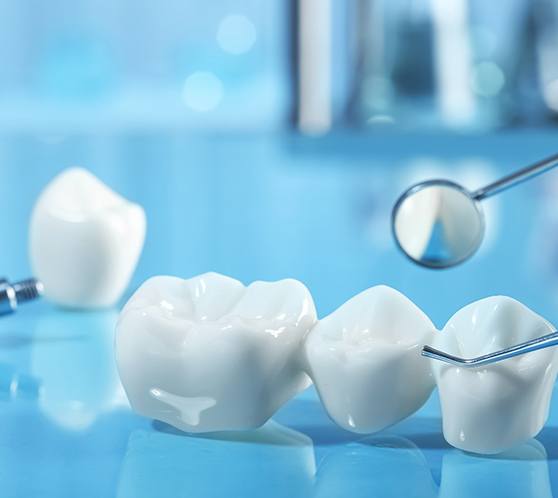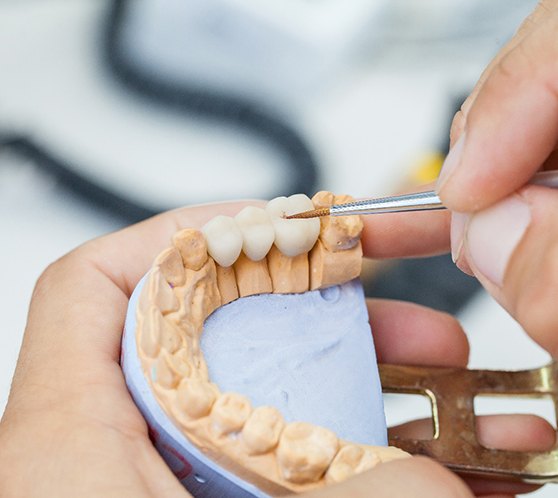Dental Bridges – Austin, TX
Get Rid of the Gaps in your Smile
Unless you’ve experienced it firsthand, you might be surprised at how much missing a single tooth can impact your life. In addition to what it does to your appearance, a gap in your smile can make it hard to speak and chew your food as effectively as you would like.
That’s part of what makes dental bridges so convenient. This restoration can get rid of the gaps in your smile, restoring your confidence and your bite strength. If you’re missing teeth, Dr. Molly Burton and the team here at Magnolia Family Dental of Austin, TX would be happy to show you what this treatment is capable of. Give us a call and we’ll bring you in for a consultation.
Why Choose Magnolia Family Dentistry For Dental Bridges?
- Dedicated Dentist who Cares Deeply for her Patients
- Advanced Imaging Technology Makes Dental Care Easy
- Compassionate Woman-Led Dental Team
What is a Dental Bridge?

Broadly speaking, dental bridges are a series of false teeth sandwiched together. Typically, two of these prostheses are used to hold the remaining ones in place and are connected either to the surrounding teeth or the jaw.
Our dental bridges are made from realistic ceramic and are best suited to patients missing one or two consecutive teeth. That said, they can be used to replace as many as four, provided that each of the missing teeth are directly next to each other.
Types of Dental Bridges

There are two different kinds of dental bridges: traditional and implant. Both have their benefits, and the one that’s best for you comes down to your individual situation. We’ll give you personalized advice as to which you should use when we meet you in person, but until then, here’s a brief overview of both options.
Traditional Dental Bridges
Traditional dental bridges are held in place by two dental crowns attached to healthy teeth. A small portion of enamel will need to be removed in order to affix the crowns in place, but this treatment allows you to replace several teeth without the need for surgery.
Implant Bridges
Implant bridges are attached to thin metal posts that are surgically placed into the jaw. This provides the dental bridge with additional stability and allows you to circumvent the need for altering healthy teeth. While the placement of the implants makes this the more expensive option, the bridge itself will typically last much longer, saving you money on replacements in the long run.
The Benefits of Getting a Dental Bridge

If you simply leave a gap in your smile, you could suffer any of a number of negative health effects. The teeth around the gap may start to shift, leading your smile as a whole to become misaligned. This impacts both how you look and how effectively your teeth are going to be able to do your job.
Dental bridges are an easy, sturdy way to fill the gaps in your smile. If you’re interested in making a real difference in the quality of your oral health, give us a call and we’ll bring you in for a consultation.
Dental Bridges FAQs
Can You Take a Dental Bridge Out?
Once Dr. Burton places your dental bridge, it’s intended to remain in your mouth for years to come. She’ll anchor it to surrounding teeth or dental implants, depending on your situation, and then it’s considered permanent. You shouldn’t be able to remove it yourself so if yours seems loose, please contact us to let us know.
Some providers offer partial dentures which they refer to as “removable bridges,” but this is somewhat misleading because they’re technically different types of restorations.
Is Getting a Dental Bridge Painful?
You shouldn’t feel any discomfort during your procedure because our team will numb the area first with a local anesthetic. If you’re overly anxious or have a hard time sitting still for long periods, we can also administer sedatives to help you feel at ease.
Then, Dr. Burton must remove some of the enamel from the abutment teeth so that the bridge can fit over them without appearing overly bulky. It’s normal to feel somewhat sore and sensitive for a few days after this preparation. However, symptoms are usually mild and can be addressed with over-the-counter medications like Tylenol or ibuprofen.
If you develop a toothache that doesn’t subside or gets worse, please contact us immediately.
Are Dental Bridges Covered by Insurance?
Dental insurance often covers about 40-50% of the total cost of your dental bridge. Policies can vary greatly depending on the provider, though, so it’s important to check what’s included in yours. There may also be additional restrictions that you need to be aware of. For example, your policy might include a waiting period that must pass before coverage kicks in. Sometimes there’s even a restriction on the number of teeth that can be treated.
If you’re not sure whether your insurance will reimburse you, feel free to ask our friendly office staff for help. They’re familiar with many different policies and are happy to help you make the most of the benefits available to you. They can also help you apply for flexible financing with CareCredit if you don’t have a plan.
How Many Teeth Can a Dental Bridge Replace?
Dental bridges are used to replace one to four missing teeth consecutively, but it depends on your unique circumstances. They’re often used to replace only one or two because the more pontics that are included, the less stable they can become. It could be risky to use them to fill larger gaps in your grin, but if you have healthy teeth on either side, it’s still feasible.
How Long Should a Dental Bridge Last?
On average, you can expect your dental bridge to last anywhere between five and fifteen years, but this can vary depending on the materials used to create it. Dental bridges made from metal typically have a longer lifespan than metal-free options, however this is not always the case. Furthermore, this difference is often negligible.
More so than the materials used, the longevity of your prosthetic depends on a variety of individual factors including your diet, oral hygiene, and whether you have any bad oral habits like smoking, nail-biting, teeth grinding (bruxism), or crunching ice cubes.
Bridges that are replacing front teeth may last slightly longer than those in the back of the mouth, as they are not subjected to as much wear and tear from chewing.
If your bridge is supported by dental implants, it will likely last much longer than a traditional bridge. While the restoration itself will need to be replaced eventually, the implant posts should remain in place for several decades with proper care.
Is a Partial Denture the Same as a Bridge?
No, but it’s easy to see why patients are often confused by this. Some people refer to partial dentures as “removable bridges,” however they are not the same thing as a traditional fixed bridge.
A dental bridge is designed stay in place for many years and can only be removed by your dentist. Conversely, a patient can remove a partial denture at any time.
The other main difference between the two is that bridges can only replace missing teeth if they are consecutive, while partial dentures can restore several teeth at various places along your arch.
Bridges are anchored in place via two crowns that are fitted over two of your natural teeth, while partials typically use metal clips or clasps that go behind your natural teeth.
Dr. Burton will review your options with you to determine which tooth replacement will best suit your individual needs.
Can Dental Bridges Be Whitened?
No, they cannot. No matter what materials your bridge is made of, there is no way to whiten it like you can your natural teeth. That’s because your natural tooth enamel has tiny pores through which bleaching agents can enter and break apart stains. Dental restorations such as dental bridges do not, and thus they will always remain the same color.
Metal-free bridges are designed to blend seamlessly with your remaining teeth, matching as closely to their shade as possible.
To minimize the risk of your natural teeth standing out against your bridge, speak to Dr. Burton about professional teeth whitening prior to the placement of your bridge. This way, your bridge can be matched to your ideal shade of teeth.
Can Dental Bridges Get Cavities?
Technically, while it is impossible for a bridge itself to develop cavities, the natural teeth underneath your bridge still can.
Food debris, bacteria, and plaque can become trapped beneath the pontics or the space where your crowns meet your gums, increasing your risk of cavities and gum infections. This is more likely to occur if you have poor oral hygiene, which is why it is extremely important to clean under and around your bridge every single day.
If your bridge is nearing the end of its lifespan, the cement holding it in place is at risk for developing cracks. Bacteria could enter those cracks, leading to infection or decay in the underlying teeth.
